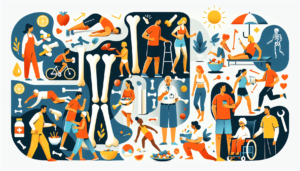Exercise and Cholesterol: How Physical Activity Can Help
Exercise and Cholesterol: How Physical Activity Can Help
Cholesterol is a waxy substance found in your blood, essential for building healthy cells. However, high levels of low-density lipoprotein (LDL) cholesterol—often referred to as "bad" cholesterol—can lead to health complications, including heart disease and stroke. This article delves into how physical activity can positively influence cholesterol levels while offering actionable insights, supported by research.
Understanding Cholesterol Basics
Cholesterol travels through the bloodstream in lipoproteins. Two major types are:
- Low-Density Lipoprotein (LDL): Often called "bad" cholesterol, high levels can lead to plague buildup in arteries, increasing risk for heart disease.
- High-Density Lipoprotein (HDL): Known as "good" cholesterol, HDL helps remove LDL cholesterol from the bloodstream.
Regular exercise is linked with improved cholesterol profiles. Quality physical activity can lower LDL cholesterol and increase HDL cholesterol levels, ultimately reducing cardiovascular risks.
The Science Behind Exercise and Cholesterol
Mechanisms of Action
When you exercise, several physiological changes occur that can help improve your cholesterol levels:
- Increase in Enzymatic Activity: Exercise elevates the activity of enzymes that help in the transport of LDL cholesterol to the liver for processing and removal from the body.
- Weight Management: Regular physical activity helps with weight loss and weight management, which can improve overall cholesterol levels.
- Improved Insulin Sensitivity: Exercise enhances the body’s sensitivity to insulin. Better insulin sensitivity leads to reduced blood sugar levels, which can lower LDL cholesterol.
- Enhanced Lipid Profile: Studies suggest that exercise can contribute to a more favorable lipid profile, characterized by higher HDL cholesterol and lower triglycerides.
Types of Exercise Beneficial for Cholesterol
Different types of exercise contribute to cholesterol management:
Aerobic Exercise
Aerobic activities increase your heart rate and breathing rate and are especially effective in managing cholesterol:
- Running: Engaging in running can elevate HDL while reducing LDL.
- Cycling: Whether stationary or on the road, cycling can yield similar benefits to running in terms of enhancing cardiovascular health.
- Swimming: This low-impact activity is perfect for individuals seeking joint-friendly exercise while still effectively managing cholesterol levels.
Resistance Training
In addition to aerobic exercise, strength training aids in cholesterol management:
- Weight Lifting: Combining resistance exercises with cardio may yield better results in improving lipid profiles than cardio alone.
- Bodyweight Exercises: Push-ups, squat variations, and resistance bands can enhance HDL cholesterol and promote weight loss.
High-Intensity Interval Training (HIIT)
HIIT combines short bursts of intense activity with intervals of rest or lower-intensity exercise. This method is effective for:
- Boosting Metabolic Rate: Even after the workout, your metabolism remains elevated longer, promoting further benefits.
- Time Efficiency: Quick, intense workouts make it easier for individuals with a busy schedule to incorporate exercise into their routine.
Recommended Exercise Guidelines
The American Heart Association recommends at least 150 minutes of moderate-intensity aerobic exercise weekly or 75 minutes of vigorous-intensity exercise. Here are suggestions to help achieve these guidelines:
- Set Realistic Goals: If you’re starting, aim for 10 to 15 minutes a day, gradually increasing duration or intensity.
- Mix It Up: A combination of aerobic and strength-training exercises at least two days a week maximizes benefits.
- Stay Consistent: Establishing a routine is crucial. Find a time that fits your schedule, creating a sustainable exercise habit.
Additional Lifestyle Considerations
Integrating exercise with other healthy lifestyle choices can amplify your cholesterol management efforts.
Nutrition
Nutrition plays a critical role alongside physical activity in managing cholesterol levels.
- Increase Fiber Intake: Soluble fiber, found in foods like oats, beans, and apples, helps reduce LDL cholesterol.
- Healthy Fats: Incorporate sources of healthy fats such as avocados, nuts, and olive oil, which can improve HDL cholesterol levels.
- Limit Sugars and Trans Fats: Avoid processed foods high in added sugars and trans fats, which can negatively impact your lipid profile.
Weight Management
Excess body weight, particularly around the abdomen, contributes to higher LDL cholesterol and lower HDL cholesterol. Combining exercise with a balanced diet can help reduce weight and enhance heart health.
Smoking Cessation
If you’re a smoker, quitting can improve HDL cholesterol levels and overall cardiovascular health. Support through counseling and medication can help increase success rates.
Psychological Factors
Improving cholesterol levels isn’t purely a physical journey but also a psychological challenge. Mental health plays a significant role in maintaining an active lifestyle.
- Stress Management: Chronic stress can lead to unhealthy coping mechanisms, such as overeating or a sedentary lifestyle. It’s important to find healthy ways to cope, including mindfulness, yoga, and meditation.
- Social Support: Engaging in exercise with friends or community groups can boost motivation and adherence to physical activity routines.
Tracking Progress
Keeping track of your exercise efforts and cholesterol levels can help maintain motivation. Many tools are available for tracking progress:
- Use Fitness Apps: Several smartphone applications can track workouts, nutrition, and cholesterol levels, providing insights into your progress and areas for improvement.
- Regular Check-ups: Schedule regular check-ups to monitor cholesterol levels with your healthcare provider, adjusting your exercise and dietary plan as needed.








